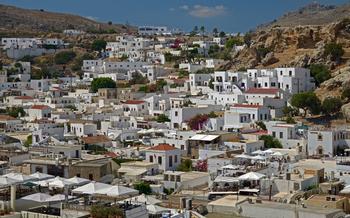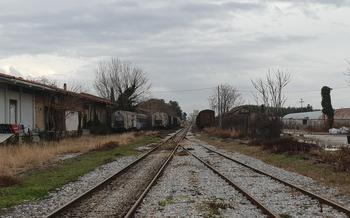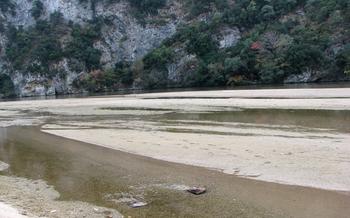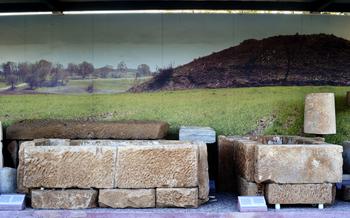
Archaeological site of Maroneia
- A Stroll in the Heart of Maroneia:
- Historical Background:
- Key Events and Landmarks:
- Architectural Highlights:
- Local Recommendations:
- A Journey Through Maroneia's Archeological Heritage
- The Walls of Maroneia: A Testament to Ancient Fortifications
- Acropolis of Maroneia: Unveiling the City's Citadel
- Maroneia's Ancient Theatre: A Stage for Cultural Expression
- Exploring the Nekropolis: A City of the Dead
- The Sanctuary of Apollo: A Center of Religious Worship
- The Archaeological Museum of Komotini: A Treasure Trove of Maroneia's Past
- Festivals and Events in Maroneia: Celebrating History and Culture
- Local Cuisine and Flavors of Maroneia
- Sustainable Tourism in Maroneia: Preserving the Past for the Future
- Accessibility and Practical Information
- Exploring the Region: Beyond Maroneia's Borders
- Insider Tip: Unveiling Hidden Gems
A Stroll in the Heart of Maroneia:
Maroneia, an ancient city in northeastern Greece, offers a captivating blend of history, culture, and natural beauty. The city's rich past is reflected in its well-preserved archaeological sites, while its vibrant present is evident in the bustling streets and friendly locals. Take a leisurely stroll through the heart of Maroneia and discover its hidden gems, from historic landmarks to charming shops and traditional tavernas.
Historical Background:
Maroneia's history dates back to the 7th century BC when it was founded by colonists from the island of Chios. The city quickly rose to prominence as a major trading center, minting its own coins and establishing commercial ties with distant lands. Maroneia's strategic location on the Aegean Sea made it a coveted prize, leading to its conquest by various empires throughout history, including the Persians, Romans, and Ottomans.
Key Events and Landmarks:
Maroneia's rich history has left an indelible mark on the city's landscape. Admire the impressive city walls, which once protected Maroneia from invaders, and explore the ancient Agora, the bustling marketplace where citizens conducted business and socialized. Don't miss the Acropolis, the city's fortified citadel, which offers stunning panoramic views of the surrounding countryside.
Architectural Highlights:
Maroneia's architectural heritage is a testament to its diverse cultural influences. Admire the Byzantine churches, with their intricate mosaics and frescoes, and the imposing Ottoman mosques, symbols of the city's Islamic past. Stroll along the picturesque cobblestone streets, lined with traditional houses featuring intricate stonework and wooden balconies.
Local Recommendations:
For a taste of Maroneia's culinary delights, head to one of the many traditional tavernas serving fresh seafood, grilled meats, and local wines. Indulge in the famous "Maroneia loukoumi," a sweet delight made with locally produced honey and almonds. For shopping, explore the local boutiques and shops, where you can find unique handicrafts, traditional textiles, and local products.
A Journey Through Maroneia's Archeological Heritage
Maroneia's archaeological site is a testament to the city's rich history and cultural significance. Excavations have revealed the remains of an ancient city that flourished from the 7th century BC to the 6th century AD. The site encompasses a vast area, including the city walls, the Acropolis, the ancient theater, the Nekropolis, the Sanctuary of Apollo, the Agora, and various other structures.
The historical context of the site is equally fascinating. Maroneia was initially founded as a Greek colony and quickly rose to prominence as a major trading center in the region. Its strategic location on the Aegean coast allowed it to establish commercial ties with other Greek city-states, as well as with the Persian Empire and beyond. Maroneia's prosperity is evident in the impressive remains of its public buildings, temples, and fortifications.
Major discoveries at the site include well-preserved mosaics, intricate sculptures, and finely crafted pottery. These artifacts provide valuable insights into the daily life, artistic traditions, and religious practices of the ancient Maroneians. Archaeological techniques employed at Maroneia include systematic excavations, surface surveys, and geophysical prospection. These methods have helped uncover hidden structures, map out the city's layout, and piece together the story of its past.
The Walls of Maroneia: A Testament to Ancient Fortifications
The fortifications of Maroneia stand as a testament to the city's strategic importance and resilience throughout history. Constructed in the 4th century BC, the walls were designed to protect the city from invasions and attacks. The walls, which stretch for approximately 5 kilometers, are constructed from large blocks of stone and feature towers and gates at regular intervals.
The strategic location of Maroneia, situated at the crossroads of important trade routes and near the coast, made it a desirable target for conquest. The walls provided a formidable defense, allowing the city to withstand numerous sieges and invasions over the centuries.
The construction techniques employed in the walls are a testament to the skill and ingenuity of the ancient builders. The walls were built using a combination of dry stone masonry and mortar, with large blocks of stone carefully fitted together without the use of cement. The use of towers and gates allowed for effective surveillance and control of access to the city.
Over time, the city's defense system evolved to meet changing threats and technologies. The walls were modified and strengthened, with the addition of new towers and gates, as well as the incorporation of new defensive strategies. These modifications ensured that Maroneia remained a well-defended city, able to withstand the challenges posed by its enemies.
Acropolis of Maroneia: Unveiling the City's Citadel
The Acropolis of Maroneia stands as a testament to the city's ancient power and grandeur. Perched atop a hill overlooking the surrounding landscape, the Acropolis served as the religious and administrative center of Maroneia. Its strategic location provided a commanding view of the city and the surrounding countryside, allowing for effective surveillance and defense.
The Acropolis encompasses a range of impressive structures, including temples, public buildings, and fortifications. The Temple of Athena, the city's patron goddess, is among the most notable landmarks. This Doric-style temple once housed a colossal statue of Athena, symbolizing the city's devotion and seeking her protection.
Other notable structures within the Acropolis include the Bouleuterion, where the city council convened to discuss and make important decisions, and the Prytaneion, which served as the government's administrative center. These buildings reflect the importance of civic and political life in ancient Maroneia.
The Acropolis also boasts impressive fortifications, including massive walls and towers. These defenses protected the city from potential attacks, highlighting the strategic importance of the Acropolis. The Cyclopean Walls, constructed using large, unhewn stones, are a testament to the skill and ingenuity of the ancient builders.
Today, the Acropolis of Maroneia is a protected archaeological site, undergoing ongoing restoration efforts. Visitors can explore the ruins, marveling at the architectural achievements of the past while immersing themselves in the rich history and legacy of this ancient city.
Maroneia's Ancient Theatre: A Stage for Cultural Expression
Nestled amidst the ruins of Maroneia, the ancient theater stands as a testament to the city's rich cultural heritage. Built in the 4th century BC, this impressive structure could accommodate up to 5,000 spectators, making it one of the largest theaters in Thrace. Its exceptional acoustics and intricate stage mechanisms allowed for a variety of performances, including plays, concerts, and religious ceremonies.
The theater's design reflects the architectural prowess of the ancient Greeks. Its horseshoe-shaped auditorium, with its rising tiers of stone seats, ensures optimal viewing angles for all attendees. The stage, adorned with intricate carvings and sculptures, provides a grand platform for performers. The theater's acoustics are remarkable, allowing even the faintest whisper to carry throughout the auditorium.
Beyond its architectural significance, the theater played a vital role in the cultural and social life of Maroneia. It served as a venue for theatrical performances, musical concerts, and religious rituals. The theater's stage hosted renowned actors, musicians, and poets, who traveled from far and wide to showcase their talents.
Today, the ancient theater of Maroneia stands as a symbol of the city's vibrant past. Although partially restored, it retains its grandeur and continues to captivate visitors with its architectural beauty and historical significance. During the summer months, the theater comes alive once again, hosting cultural events, concerts, and theatrical performances, allowing visitors to experience the magic of this ancient stage firsthand.
Exploring the Nekropolis: A City of the Dead
Lying just outside the city walls, the ancient cemetery of Maroneia, known as the Nekropolis, offers a glimpse into the funerary practices and beliefs of the city's inhabitants. Spread across a vast area, the Nekropolis contains a diverse array of tombs, ranging from simple pit graves to elaborate family mausoleums.
Excavations at the site have revealed a variety of burial practices, including cremation and inhumation. Tombs were often adorned with grave goods, such as pottery, jewelry, and weapons, reflecting the wealth and status of the deceased. The Nekropolis also features several communal burial chambers, known as cists, where multiple individuals were laid to rest together.
Beyond its archaeological significance, the Nekropolis holds cultural and religious importance. It was a sacred space where families and communities came together to honor their dead and commemorate their lives. The presence of elaborate tombstones and funerary monuments suggests that the ancient Maroneians placed great emphasis on the afterlife and the proper burial of their loved ones.
Ongoing archaeological excavations at the Nekropolis continue to shed light on the funerary customs and beliefs of ancient Maroneia. New discoveries are constantly being made, providing valuable insights into the lives and deaths of the city's inhabitants.
The Sanctuary of Apollo: A Center of Religious Worship
Location and significance: The Sanctuary of Apollo, a sacred site dedicated to the worship of the Greek god Apollo, was situated just outside the city walls of ancient Maroneia. It held immense religious significance as a prominent center for Apollo's cult in the region.
Architectural features and layout: The sanctuary consisted of several structures arranged around a central courtyard. The main temple, dedicated to Apollo, was a Doric-style building with a rectangular plan and a pronaos leading to the cella. Surrounding the temple were smaller shrines, altars, and votive offerings dedicated to various deities and heroes.
Rituals and ceremonies: The sanctuary served as a venue for numerous religious rituals and ceremonies. Devotees would gather to offer sacrifices, prayers, and votive offerings to Apollo and other deities. Festivals and special events were held throughout the year, attracting pilgrims and visitors from neighboring cities.
Excavation findings and artifacts: Excavations at the sanctuary have yielded a wealth of artifacts, including sculptures, inscriptions, and pottery. These findings provide valuable insights into the religious practices and beliefs of ancient Maroneia. Among the most notable discoveries are marble statues of Apollo and Artemis, as well as inscriptions recording dedications and offerings made by individuals and communities.
The Archaeological Museum of Komotini: A Treasure Trove of Maroneia's Past
Located in the heart of Komotini, the Archaeological Museum stands as a testament to the rich history and cultural heritage of Maroneia. Within its walls, visitors are transported back in time as they explore an array of artifacts and exhibits that narrate the story of Maroneia's past.
The museum's collection boasts a diverse range of artifacts unearthed from the archaeological site of Maroneia, providing a glimpse into the daily lives, customs, and artistic expressions of the ancient city's inhabitants. From exquisite pottery and intricate jewelry to sculptures, coins, and tools, each artifact tells a unique tale of Maroneia's past.
Interactive exhibits and educational programs bring the museum's collection to life, allowing visitors to engage with the history and culture of Maroneia in a dynamic and immersive way. Through hands-on activities, multimedia presentations, and guided tours, visitors gain a deeper understanding of the ancient city's significance and its contributions to the region's rich tapestry of history.
Accessibility is a key priority for the Archaeological Museum of Komotini. The museum is equipped with ramps, elevators, and tactile exhibits, ensuring that visitors of all abilities can fully experience and appreciate the wonders within. Guided tours in multiple languages are also available, catering to the needs of international visitors.
Festivals and Events in Maroneia: Celebrating History and Culture
Maroneia's rich history and vibrant culture come alive during its annual festivals and events. These celebrations offer a unique opportunity to immerse yourself in the city's heritage and experience its traditions firsthand.
One of the most significant events is the Maroneia Festival, held annually in July. This festival is a grand showcase of the city's cultural heritage, featuring traditional music performances, dance shows, and art exhibitions. Local artisans and craftsmen set up stalls displaying their handmade crafts and souvenirs, allowing visitors to take home a piece of Maroneia's creativity.
Another popular event is the Wine Festival, held in September to coincide with the grape harvest season. This festival celebrates the region's viticulture and winemaking traditions. Visitors can sample a variety of local wines, learn about the winemaking process, and enjoy traditional Greek cuisine paired with fine wines.
To experience the spiritual side of Maroneia, attend the Feast of Saint George, held in April. This religious festival honors the patron saint of the city with processions, church services, and outdoor celebrations. Locals and visitors alike come together to partake in the festivities and pay homage to Saint George.
Planning a visit during festival season is an excellent way to delve deeper into Maroneia's history and culture. Immerse yourself in the vibrant atmosphere, engage with locals, and create lasting memories of your time in this ancient city.
Local Cuisine and Flavors of Maroneia
Maroneia's culinary scene offers a delectable journey into the region's rich heritage. Fresh seafood, caught daily from the nearby Aegean Sea, takes center stage in many dishes. Indulge in grilled octopus, succulent shrimp, or tender calamari, expertly prepared and infused with aromatic herbs.
Grilled meats, another local specialty, tantalize the taste buds with their smoky flavors. Sample succulent lamb chops, juicy pork souvlaki, or flavorful beef steaks, all cooked to perfection over hot coals.
Local wines from the region's vineyards complement the culinary delights of Maroneia. Sip on crisp whites, robust reds, or sweet dessert wines, each offering a unique taste of the region's terroir.
For a truly immersive experience, participate in a cooking class and learn the secrets of traditional Greek cuisine. Discover the art of preparing mouthwatering dishes using fresh local ingredients and aromatic spices.
Must-try delicacies include the sweet and flaky baklava, filled with layers of filo pastry, chopped nuts, and honey syrup. Sample the creamy tzatziki, a yogurt-based dip flavored with cucumber, garlic, and olive oil. And don't miss the aromatic melitzanosalata, a smoky eggplant dip that pairs perfectly with grilled meats and vegetables.
Sustainable Tourism in Maroneia: Preserving the Past for the Future
Maroneia's rich cultural and historical heritage attracts visitors from around the world. However, it is essential to practice responsible tourism to ensure that this heritage is preserved for future generations. Visitors can contribute to sustainable tourism by minimizing their environmental impact. This includes reducing waste, conserving water and energy, and respecting the natural environment.
Supporting local businesses and initiatives that promote sustainability is another way to contribute. Visitors can choose to stay in locally-owned hotels, eat at restaurants that use local ingredients, and purchase souvenirs from local artisans. These choices help to support the local economy and promote cultural preservation.
When visiting archaeological sites, it is important to follow the designated paths and avoid touching or removing any artifacts. This helps to protect the site from damage and ensures that future visitors can appreciate its beauty and significance.
By embracing sustainable tourism practices, visitors can help to preserve the unique heritage of Maroneia while also ensuring that future generations can enjoy this incredible destination.
Accessibility and Practical Information
Getting to Maroneia
Maroneia is conveniently located and accessible by various means of transportation. For those traveling by air, the nearest airport is Kavala International Airport (KVA), approximately 60 kilometers from Maroneia. Regular bus services connect the airport to the city of Komotini, where visitors can transfer to local buses or taxis to reach Maroneia.
Accommodation and Hotels
Maroneia offers a range of accommodation options to suit different budgets and preferences. From cozy guesthouses and family-run hotels to modern resorts, there are plenty of places to stay in the city. Visitors can choose from accommodations within walking distance of the archaeological site or opt for hotels in the city center, which offer easy access to shops, restaurants, and other amenities.
Guided Tours and Services
To enhance their visit, travelers can take advantage of guided tours led by experienced archaeologists or historians. These tours provide in-depth insights into the history, culture, and significance of the archaeological site. Visitors can also rent audio guides or hire private guides for a personalized experience.
Operating Hours and Ticket Prices
The archaeological site of Maroneia is open to the public daily, except for Mondays, from 8:00 am to 3:00 pm. Admission tickets are reasonably priced, with discounts available for students, seniors, and groups. Visitors can purchase tickets at the site's entrance.
Additional Tips
- Plan your visit during the shoulder seasons (spring or autumn) to avoid the summer crowds and enjoy more pleasant weather.
- Wear comfortable shoes as the archaeological site involves a fair amount of walking on uneven terrain.
- Bring a hat, sunscreen, and water, especially during the hot summer months.
- Take your time exploring the site and don't hesitate to ask questions to the on-site staff or guides.
Exploring the Region: Beyond Maroneia's Borders
Maroneia's rich history and archaeological treasures are only a part of what the region has to offer. Venture beyond the city limits and discover a wealth of nearby attractions and destinations that will further enrich your exploration of this captivating corner of Greece.
A short drive from Maroneia, history buffs can delve into the ancient world at the archaeological site of Abdera, once a thriving city-state renowned for its philosophers and intellectuals. Explore the ruins of its temples, theater, and agora, and immerse yourself in the stories of its past.
Nature enthusiasts will find solace in the pristine beauty of the Nestos Delta National Park, a haven for diverse flora and fauna. Hike amidst lush forests, spot rare bird species, and bask in the tranquility of this natural paradise.
For a taste of coastal charm, head to the nearby village of Fanari and its picturesque harbor. Stroll along the waterfront, savor fresh seafood delicacies at local tavernas, and soak up the laid-back atmosphere of this charming fishing village.
For those seeking a unique cultural experience, the village of Pomakohoria, inhabited by a Muslim minority group with distinct traditions, offers a glimpse into a different way of life. Visit their mosques, sample their traditional cuisine, and engage with the friendly locals who are eager to share their heritage.
Whether you seek historical wonders, natural beauty, or cultural encounters, the region surrounding Maroneia promises a tapestry of experiences that will leave you captivated and yearning for more.
Insider Tip: Unveiling Hidden Gems
Beyond the main attractions, Maroneia offers an array of hidden gems and off-the-beaten-path experiences for adventurous travelers. Venture off the main roads and explore the surrounding countryside, where you'll find secluded beaches, picturesque villages, and breathtaking natural landscapes. Ask locals for their recommendations for lesser-known tavernas serving authentic Greek cuisine and shops selling unique handmade crafts.
- Discover the secluded cove of Agios Nikolaos, a hidden beach with crystal-clear waters and stunning views.
- Visit the traditional village of Xylagani, where you can stroll through narrow cobbled streets and admire the beautifully preserved architecture.
- Embark on a scenic hike in the nearby Rodopi Mountains, where you'll be rewarded with panoramic vistas and lush forests.
- Indulge in a cooking class led by a local chef, learning to prepare traditional Greek dishes using fresh, seasonal ingredients.





